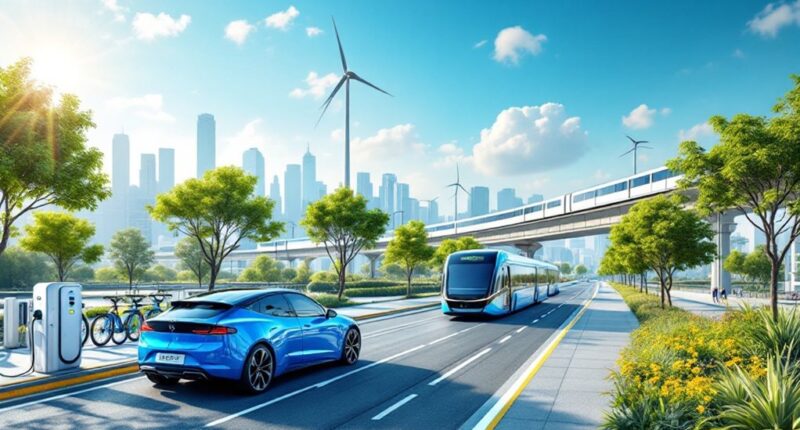Sustainable transportation options now offer impressive alternatives to gas-guzzling vehicles. Electric vehicles cut emissions by more than half compared to conventional cars, while trains produce 70-80% less greenhouse gases than cars and planes. Bicycles represent an elegant solution, emitting just 33 grams of CO2 per mile, and carpooling can reduce household emissions by 2,000 pounds annually. Smart mobility solutions may even slash urban emissions by 20%. The journey toward greener transportation continues to accelerate.

The race to reduce our carbon footprint has sparked a transportation revolution that’s transforming how we move from point A to point B. With electric vehicles leading the charge, we’re witnessing a paradigm shift toward cleaner mobility options that doesn’t just save the planet—it saves your wallet too.
Electric vehicles have become the poster child of sustainable transportation, cutting CO2 emissions by more than half compared to conventional cars. At 161 grams per mile versus a gas-guzzler‘s 374, EVs offer environmental redemption while padding your bank account with potential savings of $21,500 over their lifetime.
EVs slash emissions by more than half and reward your environmental consciousness with a $21,500 lifetime bonus.
Sure, battery manufacturing still accounts for a third of lifetime emissions—like having a chocolate cheat day on your otherwise perfect diet—but as renewable energy grows, those numbers shrink faster than ice cream on a hot sidewalk. Just as regenerative farming practices restore soil health in sustainable agriculture, EV manufacturers are working to minimize the environmental impact of battery production.
For the communally-minded traveler, public transportation offers impressive eco-credentials. Buses puff out a modest 100 grams of CO2 per mile, while trains glide along at just 88 grams—efficiency that would make your grandmother’s budget-stretching skills proud. Trains stand out as one of the greenest travel methods, emitting 70-80% less greenhouse gases than cars and planes.
Cornell University has made this work brilliantly, with 89% of students embracing sustainable commuting options.
The humble bicycle represents perhaps the most elegant transportation solution ever devised. Regular bikes emit a mere 33 grams of CO2 per mile, while e-bikes—nature’s gift to the uphill-averse—clock in at a minuscule 8 grams.
Meanwhile, walking remains the OG zero-emission transit method, offering bonus points for cardiovascular health.
For those not ready to ditch their cars entirely, carpooling reduces greenhouse gas emissions by up to 2,000 pounds annually per household—roughly the weight of a small hippo.
Alternative fuel vehicles powered by hydrogen or biofuels provide additional paths forward, serving as stepping stones to a fossil-fuel-free future.
Flexible Fuel Vehicles offer an accessible transition option as they can operate effectively on a mixture of E85 ethanol and traditional gasoline.
The transportation landscape is further evolving through smart mobility solutions that leverage data analytics to optimize traffic flow and reduce congestion.
Like a chess grandmaster planning several moves ahead, these systems could potentially slash urban emissions by 20%, proving that sometimes the smartest vehicle is the one that knows when not to move at all.
Frequently Asked Questions
How Much Can Sustainable Transportation Reduce My Carbon Footprint?
Sustainable transportation can dramatically shrink one’s carbon footprint.
Public transit reduces emissions by 4,800 pounds annually per person, while electric vehicles cut up to 16,200 pounds per household.
Walking and cycling eliminate direct emissions entirely, saving around 1,000 pounds yearly.
Even carpooling slashes commute emissions by 50%, reducing household carbon by 2,000 pounds annually.
These options collectively offer significant environmental benefits while maintaining mobility needs.
What Government Incentives Exist for Green Transportation Choices?
The government offers numerous incentives to encourage green transportation choices.
These include federal tax credits up to $7,500 for new electric vehicles, state rebates ranging from $1,000-$5,000, and tax-free employer transit benefits up to $280 monthly.
Infrastructure funding includes $5 billion for the National Electric Vehicle Infrastructure Program and tax credits for home charging equipment.
Additional perks may include HOV lane access, reduced parking fees, and special utility company rebates for charging equipment installation.
Are Electric Vehicles Truly Better for the Environment?
Electric vehicles offer significant environmental benefits, but with caveats. They produce zero tailpipe emissions and generate 50% fewer lifetime emissions than gas vehicles on average.
However, battery production creates substantial carbon emissions initially. The environmental equation depends heavily on electricity sources—EVs charged with renewable energy deliver maximum benefits.
Despite manufacturing impacts, most EVs reach their emissions break-even point within 6-18 months, making them increasingly advantageous as power grids become cleaner.
How Can Rural Communities Implement Sustainable Transportation Solutions?
Rural communities can implement sustainable transportation by adopting on-demand transit systems that reduce costs while boosting ridership by 40%.
Electric vehicle initiatives, supported by federal tax credits, help address range anxiety through strategic charging infrastructure.
Sustainable freight solutions like route optimization and alternative fuel vehicles tackle the growing emissions from trucks.
Communities can leverage the $7.5 billion from the Infrastructure Law and form public-private partnerships like the successful Míocar carsharing program in rural California.
What Is the Payback Period for Investing in Sustainable Vehicles?
Payback periods for sustainable vehicles vary greatly across technologies.
EVs can reach payback in as little as 19 months, with the 2024 Polestar 2 achieving this milestone.
Hybrid vehicles typically require around 4 years to recoup initial investments through fuel savings.
Natural gas vehicles have variable payback periods due to energy market fluctuations, while Low Rolling Resistance tire systems for commercial trucks offer remarkably quick returns, paying for themselves in just 6-14 months.









